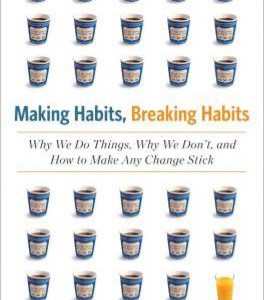I wake up every morning, put on my workout clothes and go to the gym. After that, I come home, take a shower and I’m off to work. My car knows how to get me to the office and there are times that I don’t even know how I got there.
This happens because everything we do is a habit and it all becomes systematic. Think about it. What are your daily routines? Do you find yourself doing the same thing every day?
I do. That’s why I wanted to review the book, Making Habits, Breaking Habits: Why We Do Things, Why We Don’t, and How to Make Any Change Stick by Jeremy Dean. I wanted to learn how habits are formed and how to break bad habits. Dean teaches you how by first taking a habit and breaking down the anatomy of it. He then talks about several studies and teaches the reader how to become aware so that if he/she wants to change something he/she could change it.
The book is lined with psychological studies conducted by famous and not so famous psychotherapists, all researching habits. It’s quite interesting to read and it makes you realize that you’re not alone. He also points out that environment and/or social issues can influence habits.
In Making Habits, Breaking Habits, Dean looks at how habits are formed and where they come from. He says it takes an average of 66 days to make a habit stick. Next he looks at places where habits are formed – socially (for example, when you meet friends, you tend to meet them at a restaurant or bar to socialize. Drinks and food become associated with friends), work, exercise, eating and more.
Why can’t people lose weight? It’s because they have a habit of eating certain foods that make them gain weight. It’s all part of the habit of what we eat. I, for one, find myself making chicken parm on certain nights of the week and meatballs on other nights. Many families have fish Friday evenings. They may eat fish because it’s a custom, but then it becomes a long-standing habit.
So how do you change a habit? For starters, Dean says that you have to look at the motivation of why you want to make a change. He says to make sure the habit is obvious and use visualizations to see what you want. He also says that we all need to be careful when making changes, because we tend to make many changes at the same time and then we become unsuccessful.
Dean suggests that if you want to make a habit, become aware of the habit. When do you do it? Where does it happen? Then you should have a plan. What is your plan and how will you accomplish it? One example he uses is if there is a short trip, we should have a plan to walk instead of drive. He also says to look at what time of day you will make this habit. For example, if you want to start exercising, will you only do it in the morning? How will the habit fit into your daily routine?
Dean also says you should be mindful of negativity because that will hurt your habit. For example, you may say, “I’m too tired to exercise.” Don’t get caught up in that, instead try to find something that will motivate you to exercise. He says it’s our own minds that work against us at times.
A positive step in making sure a habit sticks is monitoring it. This reminded me of how at Weight Watchers, they tell you to monitor and write down everything that you eat. If you write it down, you won’t eat as much. You will be mindful of what you are eating.
After reading this book, it just affirms that if you really want to make a change, you can make it happen.
I recommend Making Habits, Breaking Habits for anyone who wants to make a change in his or her life. It helps to evaluate what you really want and how to get it done.
————————————————————————————————————
Article first published as Book Review: Making Habits, Breaking Habits: Why We Do Things, Why We Don’t, and How to Make Any Change Stick by Jeremy Dean on Blogcritics.


